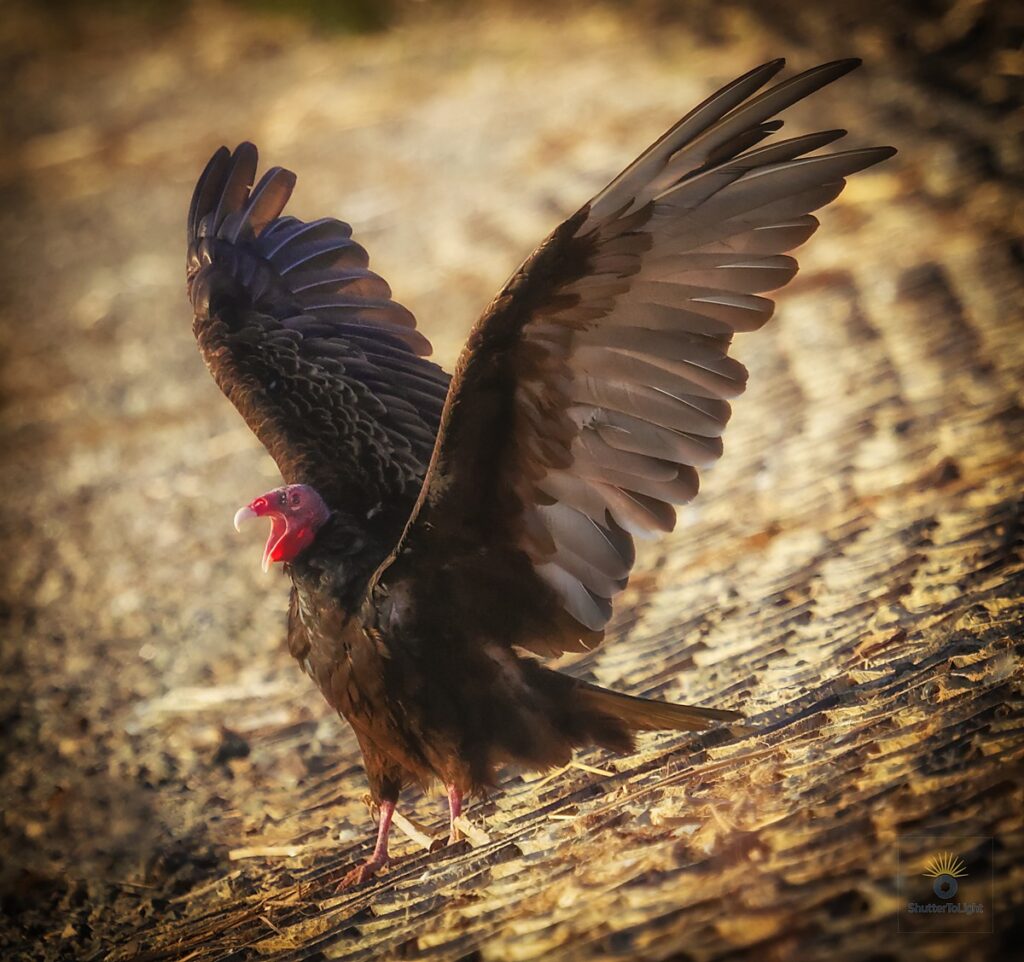Winged Victory of Wild Turkey Vulture
A sculpture in motion, seen through feathers and fate.
野生红头美洲鹫的胜利女神
一尊雕像,在羽翼与命运之间展翅。
Victoria Alada del Buitre Americano
Una escultura viva, entre plumas y destino.
This wild turkey vulture at Ed Levin County Park gave me one of the most surprising and symbolic images I’ve captured recently, echoing the themes I explored in Kiss of Gold. I originally came hoping to find a bald eagle, but instead I encountered a creature that reminded me—unexpectedly—of the Winged Victory of Samothrace.
The Moment Behind the Shot
At the lakeshore of Ed Levin County Park in Milpitas, I was scanning for eagles when I noticed what looked like a small black chicken—actually a wild turkey vulture. It drank cautiously and circled a discarded piece of bait. I waited, curious. After 15 minutes, the moment came: it opened its beak, spread its wings, and launched into the air. What amazed me most was the sudden transformation—from a hunched, almost comical black figure pecking by the lakeshore to a majestic silhouette with wings spread wide like a victory sign. The outstretched wings and open beak radiated power and presence, a dramatic contrast to the humble forager I had watched moments before. That iconic pose—bold, proud, and full of motion—reminded me instantly of the Winged Victory sculpture I’d seen in the Louvre in 2005, a 2nd‑century BC masterpiece now at the Louvre. The vulture’s posture echoed the same sense of motion and triumph: wings poised, body aloft.
Ecological Significance of the Wild Turkey Vulture
The wild turkey vulture may appear opportunistic, but it’s a vital part of the ecosystem. These birds consume carrion, reducing disease and cleaning the environment. Their stomach acid, with a pH near 1.0, neutralizes pathogens like anthrax, botulism, and even flu viruses. They’re not just survivors—they’re nature’s cleanup crew.
Learn why vultures matter from the Audubon Community Nature Center →
Art-Historical Resonance: From Vulture to Victory
The pose of the turkey vulture—wings flared, chest lifted—immediately recalled to me the Winged Victory of Samothrace, a Hellenistic sculpture from the 2nd century BC. Discovered in 1863 on the island of Samothrace, the statue represents Nike, the Greek goddess of victory, as she lands on the prow of a ship. Though headless and armless, the sculpture exudes strength and momentum—an embodiment of triumph captured in stone.
Today, the Winged Victory commands the top of the Louvre’s Daru staircase, where its flowing drapery and forward-leaning motion continue to awe millions. Its dynamic form influenced generations of artists, from Rodin to modern cinematic imagery. That a humble vulture could mirror its spirit in real life—unrehearsed, in the wild—was a reminder that art lives not only in museums, but in nature, waiting for us to notice.
Technical Notes
- Location: Ed Levin County Park, Milpitas, California
- Camera: Canon R5 + EF 100–400mm with 1.4x extender
- Settings: 1/8000 sec, ISO 6400
- Post-processing: ON1 Photo RAW – reduced noise, subtle sharpening, light vignette
The ground has a mesh structure from the lake’s edge, which made the background feel a bit artificial. Next time, I’ll try to position for a more natural setting. Still, the dramatic winged victory pose of this wild turkey vulture made the shot a winner.
Photographic Lessons
This shot reminds me that wildlife moments are unpredictable. Birds often give a hint—like flapping wings—before taking off. Smaller birds move even faster. With the Canon R5 Mark II’s pre-shooting mode, I caught the exact second of takeoff I might otherwise have missed. Pre-shooting is a game-changer for moments like this—unlike mid-air captures such as in Kiss of Gold, where I relied on sharp instincts and fast tracking during the action itself.
Stay ready. Stay open. The most ordinary subject can become a monument when the light and motion align.

